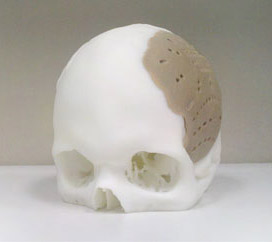Printed prosthetic replaces 75 percent of man's skull

Popular Science reports that earlier this week, an anonymous man in the northeastern United States had 75 percent of his skull replaced by an implant created with 3D printing technology. This is the first ever 3D-printed skull replacement. Biomedical company Oxford Performance Materials created the implant, but had to wait for approval from U.S. regulators before the procedure could be performed.
A scan of the patient's head was completed using a 3D imaging system. The implant was then tailored to the patient's head before printing. The prosthetic was printed out layer by layer from a digital CAD file. The implant's surface has features that allow for cell and bone growth. The implant is made from a type of thermoplastic called polyetherketoneketone (PEKK), which is a polymer that's similar to bone. X-rays are not a problem for the implant; it will be seen as a transparent shadow on an X-ray.
The procedure was approved by the FDA in February this year. The implant is called the OsteoFab Patient Specific Cranial Device. OPM says that they can make a prosthetic in about two weeks, once the patient's scans have been received. The particular piece used for this case was created in just five days, according to the company's president, Scott DeFelice. Geek.com reports that 75 percent probably refers to the mass of the patient's skull rather than the surface area.
Possible treatments for the device include mending car accident victims, replacing cancerous bones in the skull, and reconstruction for people suffering from other types of head trauma. Bone implants are also being prepared for other body parts; one of OPM's current focuses is on the diabetic foot.
The possibilities for this technology are vast. According to a report by TechFleece, 500 people in the U.S. could benefit from this technology every month.
What do you think of these advances in medical technology?
Image courtesy of OPM.
2 comments